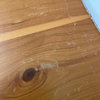X-post to Painting - Shellac disaster!
2ajsmama
13 years ago
Related Stories

DECORATING GUIDESFrom Queasy Colors to Killer Tables: Your Worst Decorating Mistakes
Houzzers spill the beans about buying blunders, painting problems and DIY disasters
Full Story
MOST POPULAR15 Remodeling ‘Uh-Oh’ Moments to Learn From
The road to successful design is paved with disaster stories. What’s yours?
Full Story
MOST POPULAR8 Great Kitchen Cabinet Color Palettes
Make your kitchen uniquely yours with painted cabinetry. Here's how (and what) to paint them
Full Story
CLOSETSHouzz Call: Is Your Closet a Storage Powerhouse?
We want to see how you are making the most of your closet storage areas. Post pictures and tell us how you’ve organized them
Full Story
TREE HOUSESHouzz Call: Show Us Your Well-Designed Treehouse or Tree Fort!
Got a great treehouse or tree fort? We want to see it! Post yours in the Comments and we’ll feature the best in a future article
Full Story
PAINTINGKnotty to Nice: Painted Wood Paneling Lightens a Room's Look
Children ran from the scary dark walls in this spare room, but white paint and new flooring put fears and style travesties to rest
Full Story
MOST POPULAR11 Reasons to Paint Your Interior Doors Black
Brush on some ebony paint and turn a dull doorway into a model of drop-dead sophistication
Full Story
COLOR12 Tried-and-True Paint Colors for Your Walls
Discover one pro designer's time-tested favorite paint colors for kitchens, baths, bedrooms and more
Full Story
REMODELING GUIDESInterior Brick: Paint it or Leave It?
Here's how to know if covering that brick is a sin or solution
Full Story
DIY PROJECTSUpcycle Furniture Finds With Paint
There are products out there designed to help you transform your thrift-store scores
Full Story









aidan_m
2ajsmamaOriginal Author
Related Professionals
Kaneohe Cabinets & Cabinetry · Wildomar Cabinets & Cabinetry · Hastings Flooring Contractors · Jamaica Plain Flooring Contractors · Kendall West Flooring Contractors · Mountain Top Flooring Contractors · Oak Park Flooring Contractors · Redlands Flooring Contractors · North Bergen Furniture & Accessories · Reno Furniture & Accessories · Asheville Furniture & Accessories · Miami Beach Furniture & Accessories · Norwalk Furniture & Accessories · Van Nuys Furniture & Accessories · Arlington Handyman2ajsmamaOriginal Author
2ajsmamaOriginal Author
aidan_m
2ajsmamaOriginal Author
aidan_m
2ajsmamaOriginal Author
sombreuil_mongrel
2ajsmamaOriginal Author
sombreuil_mongrel
2ajsmamaOriginal Author